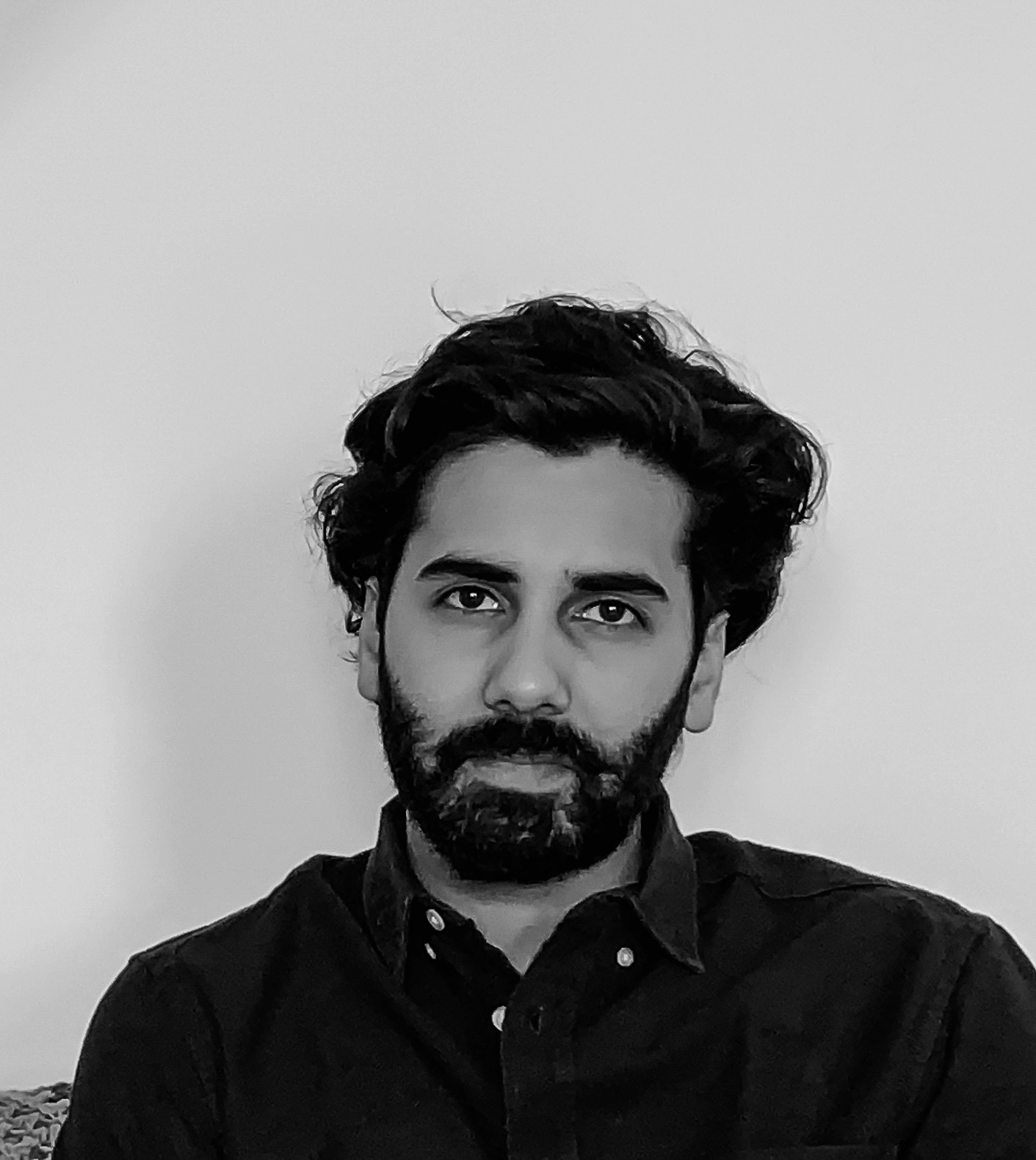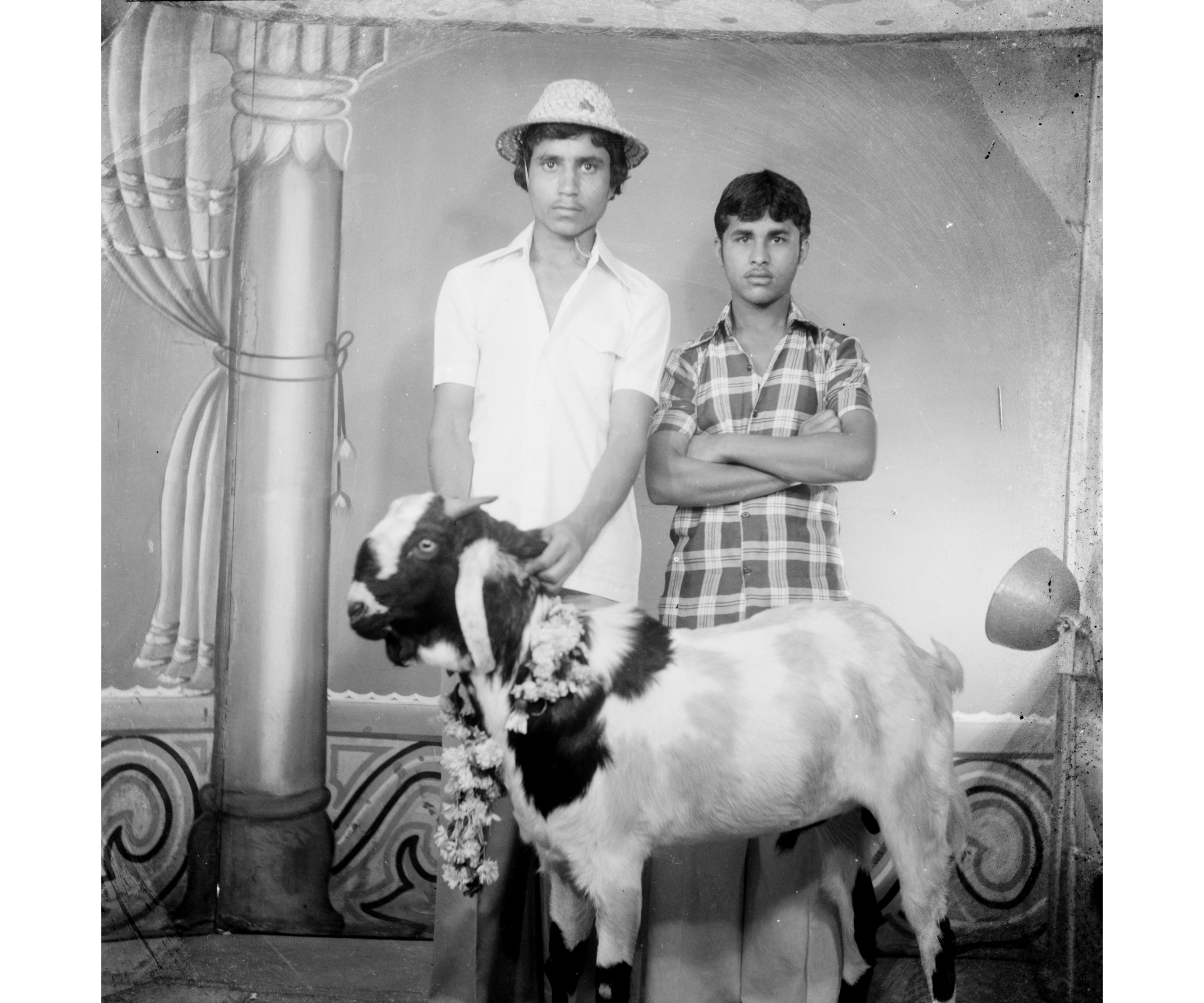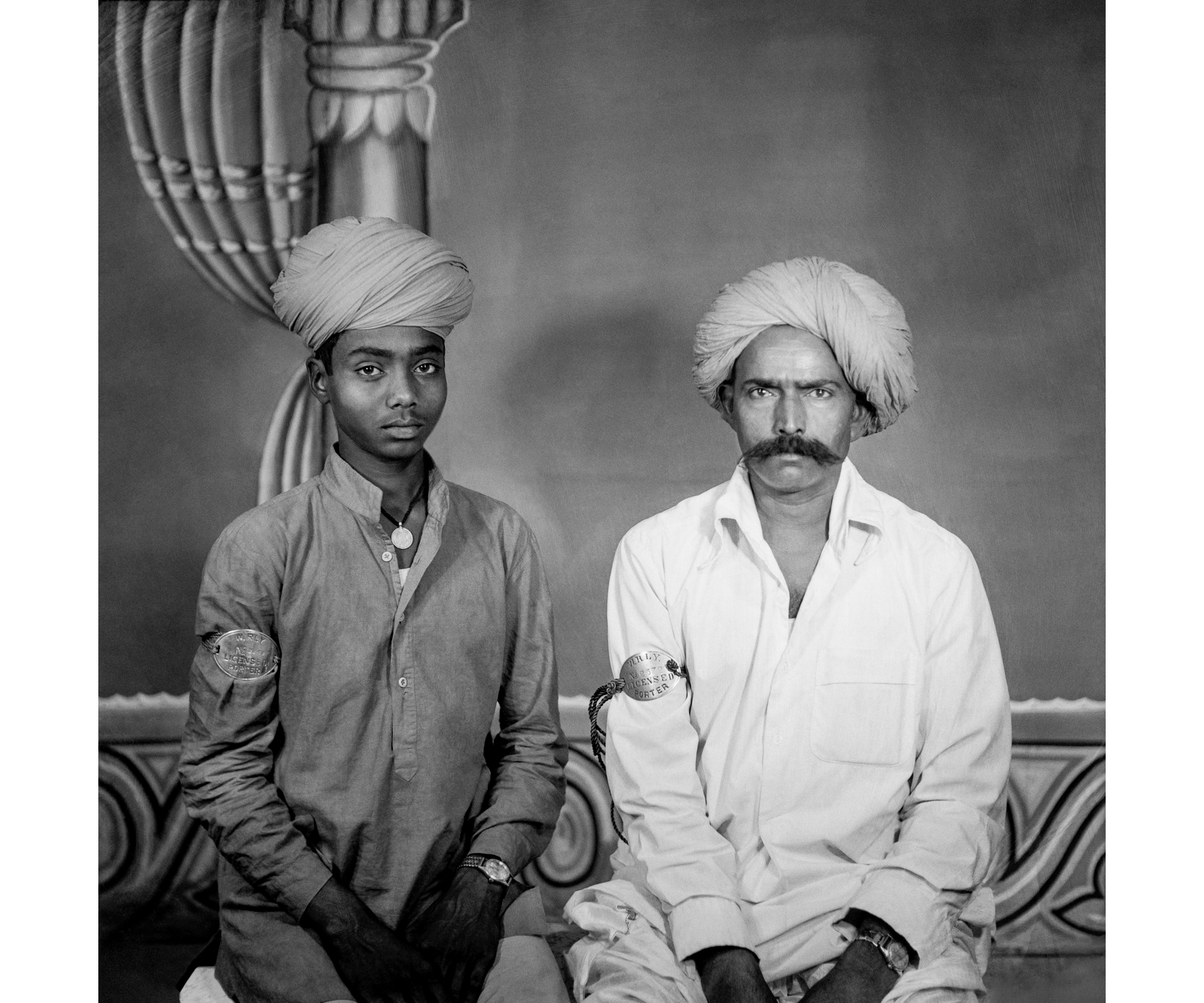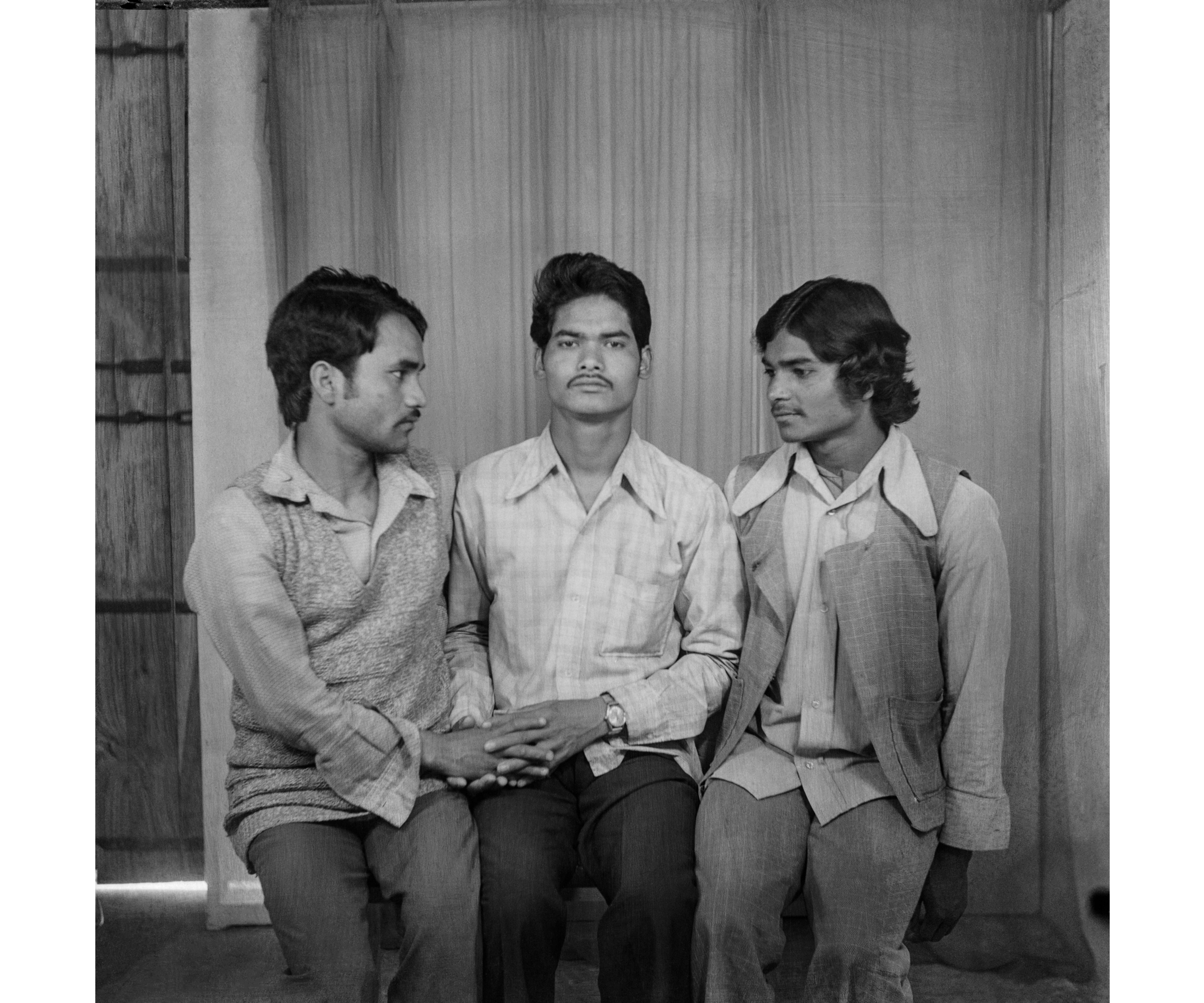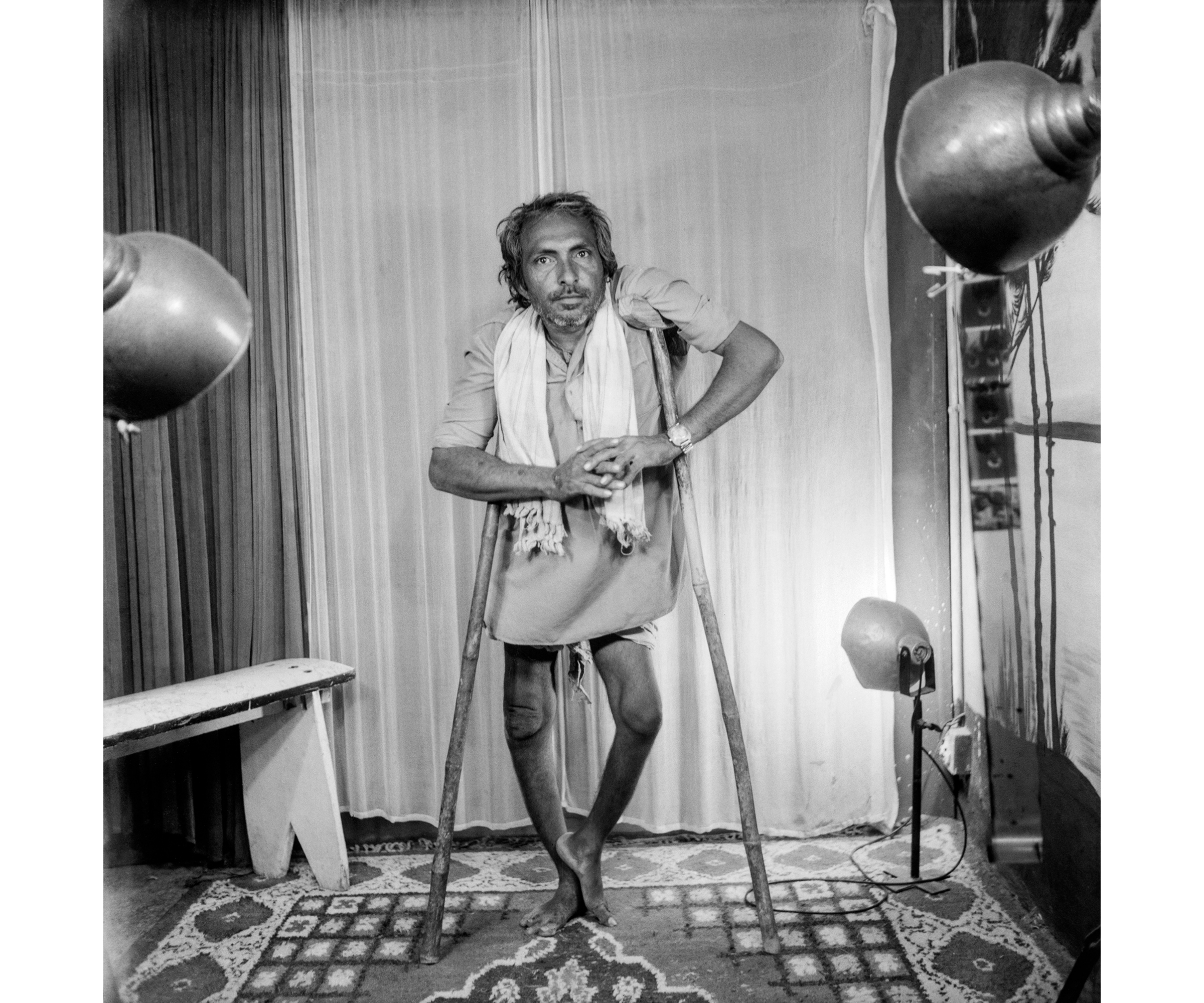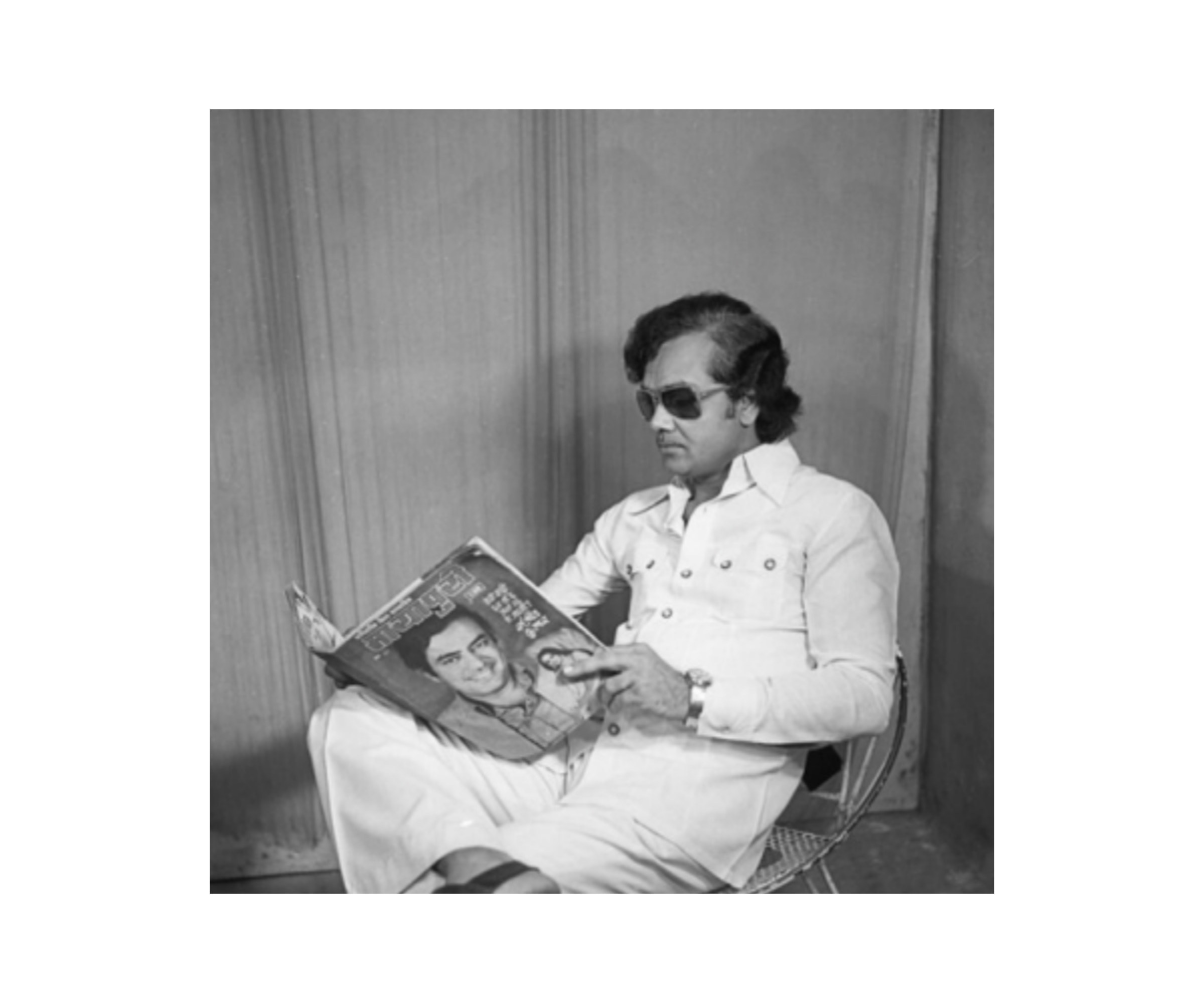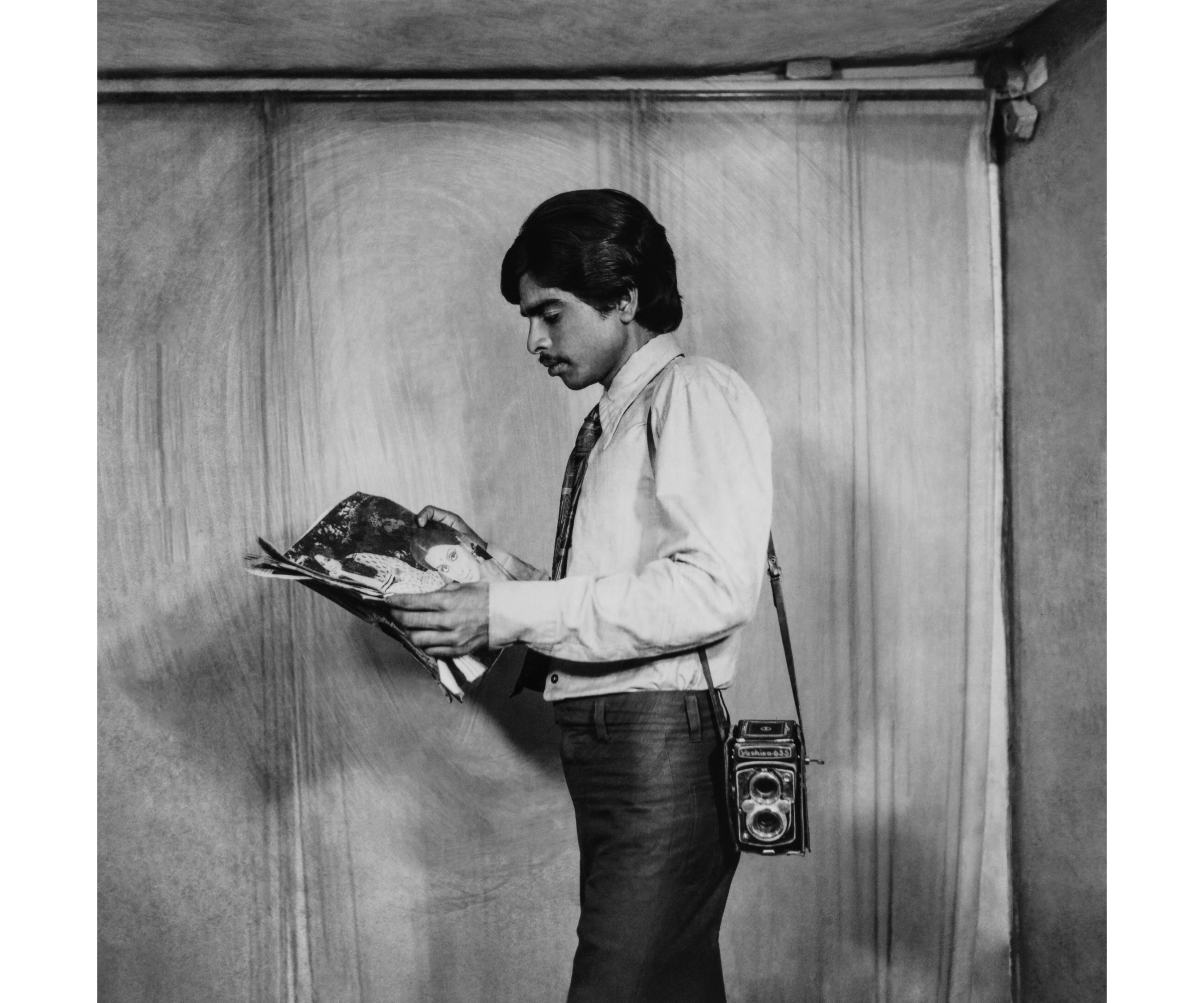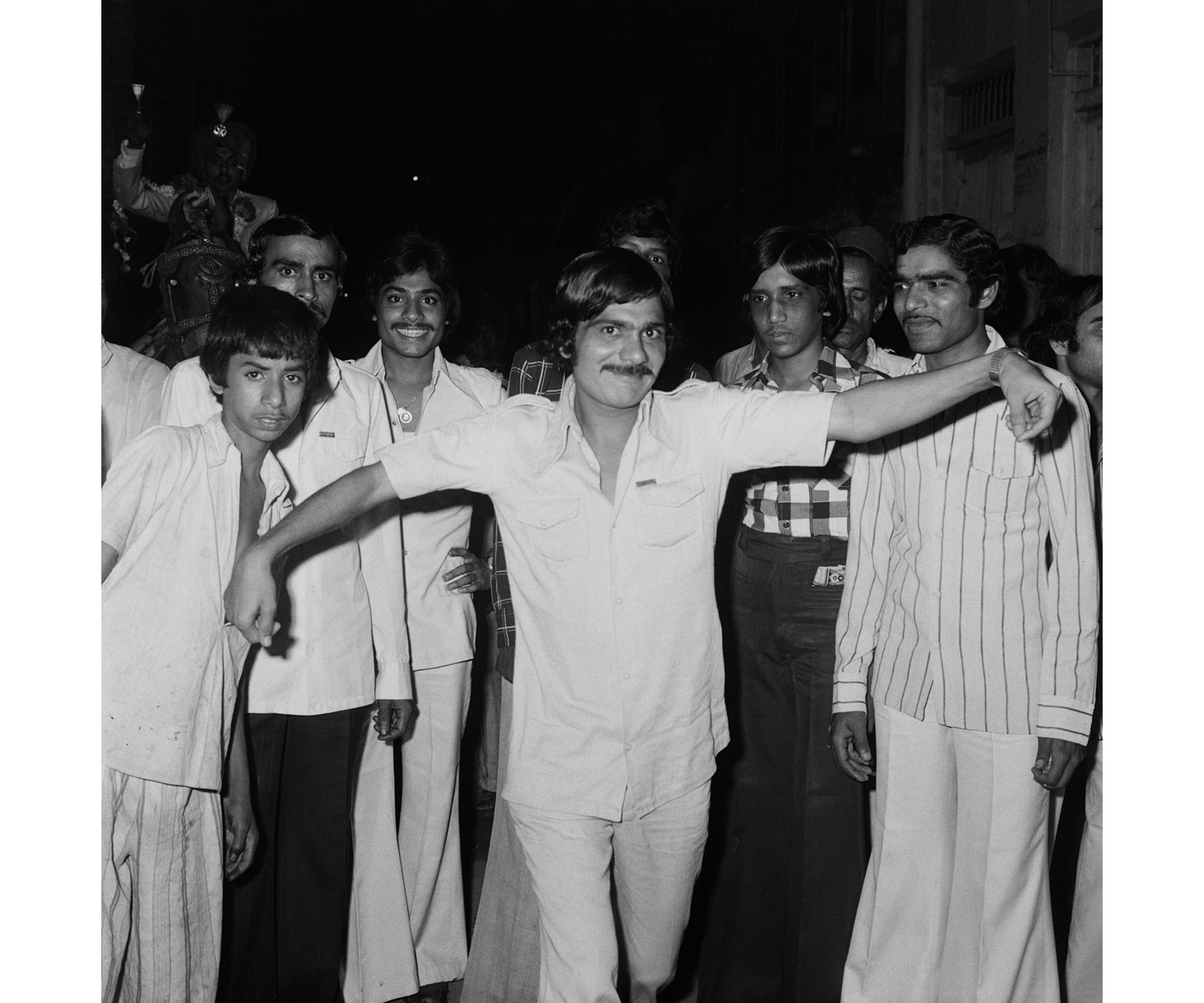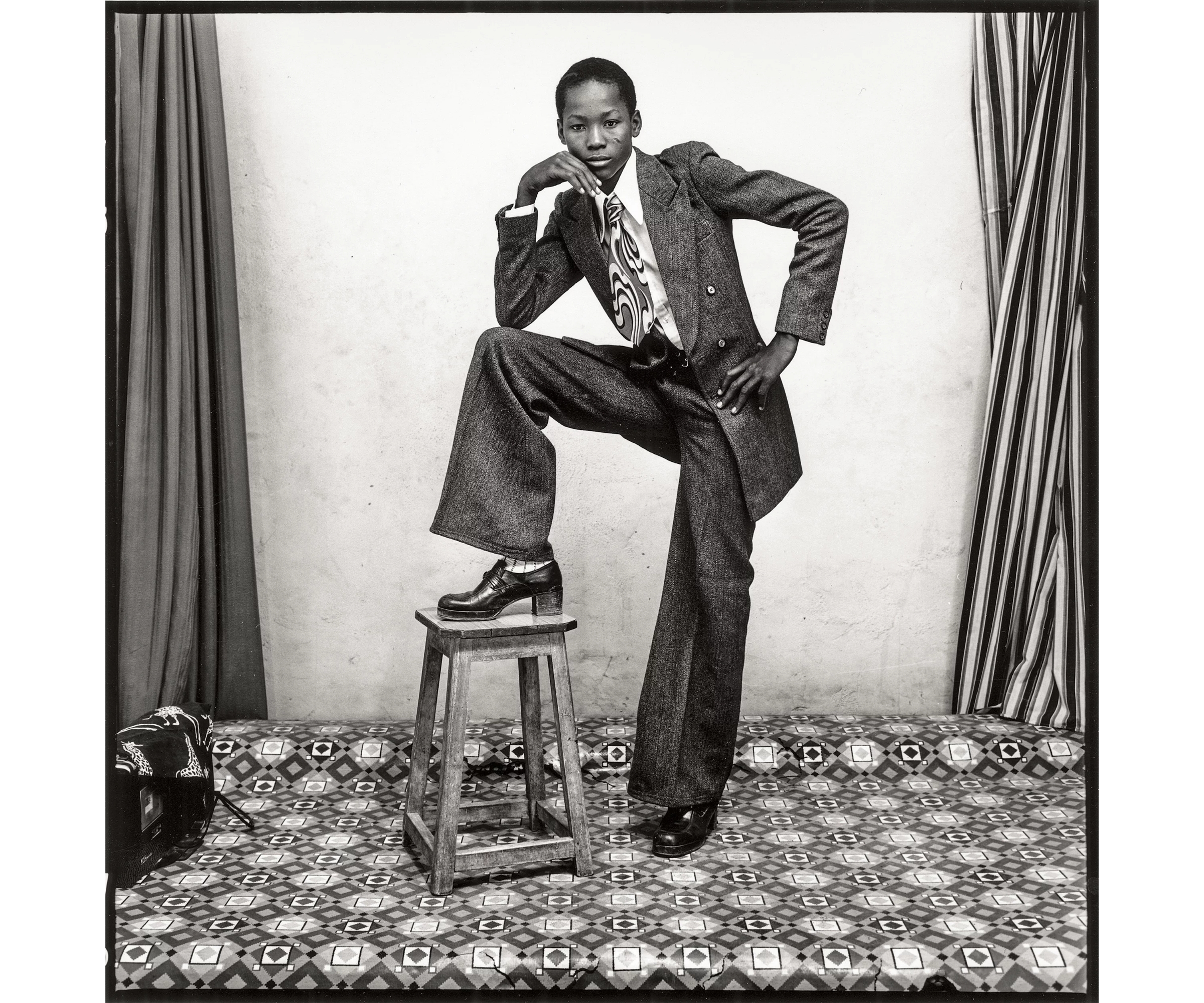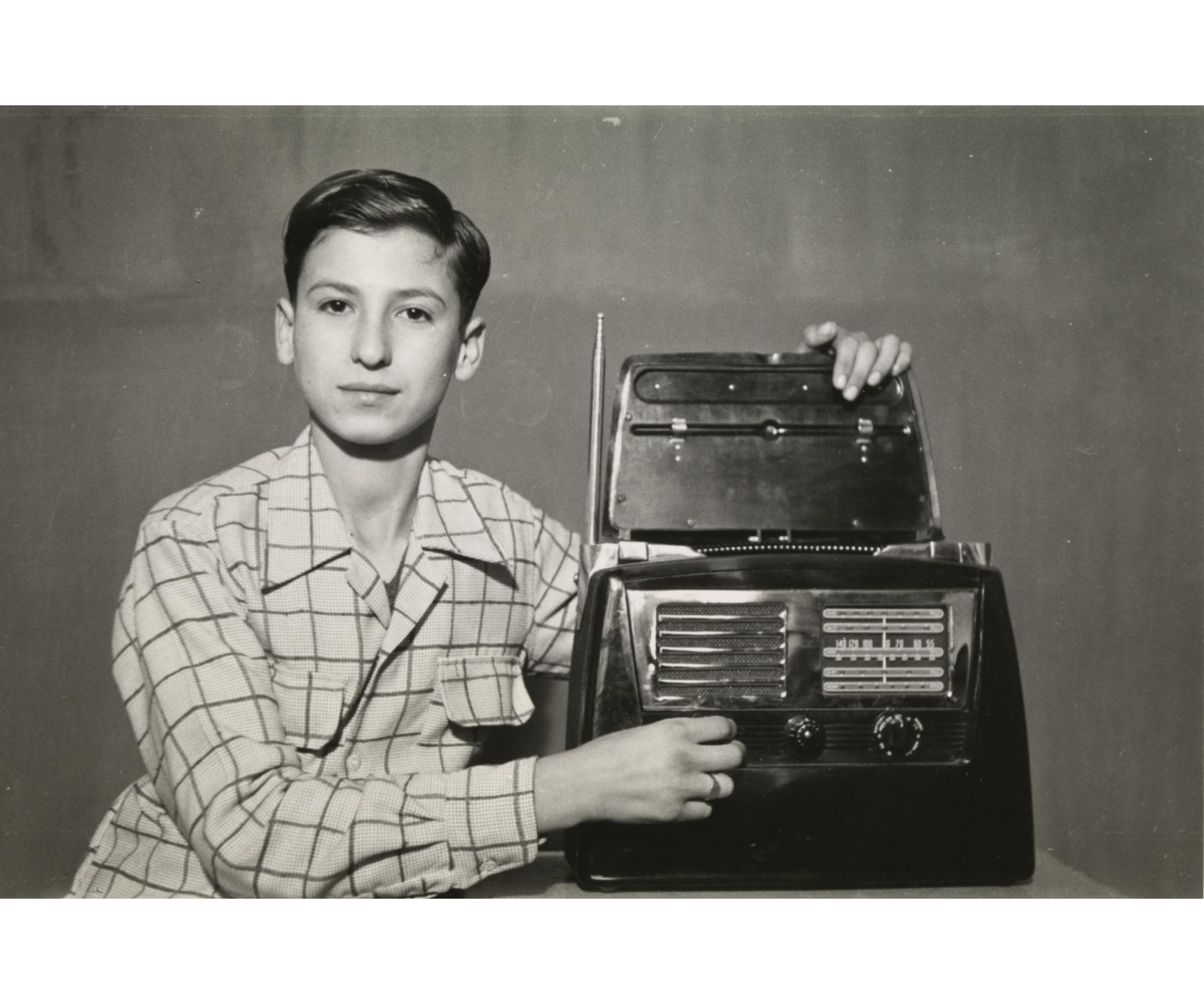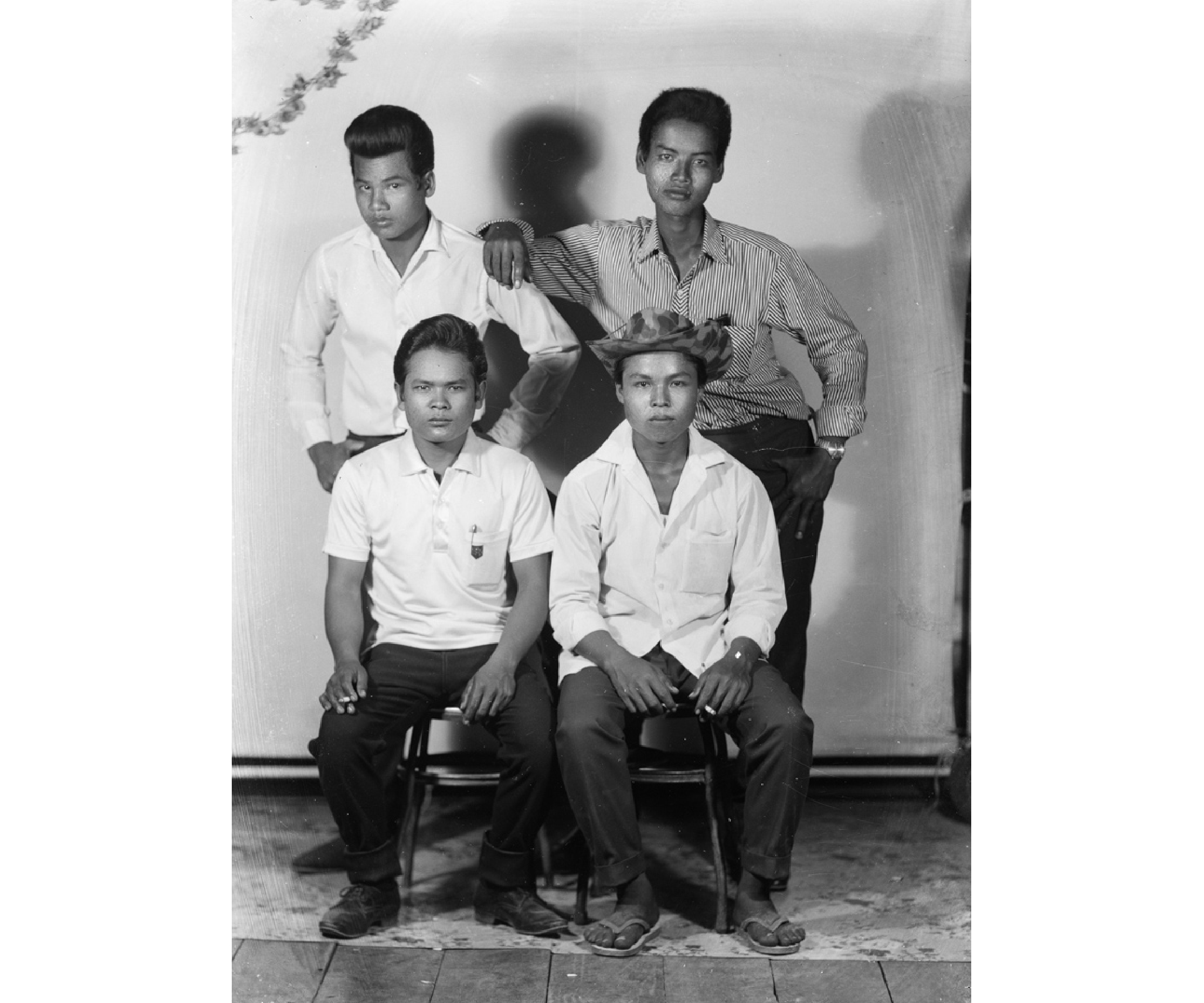PERSPECTIVES
The Business of Dreams: Photographs from the Studio of Suresh Punjabi
Thought to be dead, an aggrieved Urdu poet arrives at his own memorial service and renounces a world that saw no value in his work. In the dramatic encounter that drives the final act of Guru Dutt’s cult classic Pyaasa (1957), it’s the author who declares himself dead, plagued by an undeniably human tension in which a sturdy reality impedes a desire for transcendence. On screen, light and shadow become characters in their own right, and faces concealed by partial darkness register a deeper emotional conflict between an actual and an imagined life. As audiences, we get only a silhouette — the corporeal surface under which a potent energy brims, rendering our assumptions, allegiances and judgements imperfect.
On its release, Dutt’s film had a powerful impression on the Indian imagination, quickly becoming an exemplar of the Golden Era of Hindi Cinema, which lasted well into the 1960s. Caught up in the mania for the film, a young boy from Indore named Suresh Punjabi became enthralled by its aesthetic vision and preoccupied with replicating its approach. In the years that followed, Punjabi carried Dutt’s vision into his own work as a budding studio photographer in the central Indian town of Nagda, where he has since spent over four decades chronicling the social and personal lives of his local community
Born a decade after Independence — in the same year as the release of Pyaasa — Punjabi’s childhood coincided with a particularly meaningful period in India’s history. While much of the political, cultural and economic power resided in big cities, the country’s first prime minister Jawaharlal Nehru’s program for economic modernisation soon began injecting small and mid-sized towns with private capital and public planning.
As a result, many of these areas mushroomed into industrial hubs, in no small part due to investments from nationalist businessmen who saw in them a golden opportunity for capital-intensive production. Situated on the banks of the Chambal river that runs through western Madhya Pradesh, Punjabi’s adopted home of Nagda was one such place. Home to a major junction between the Delhi-Mumbai railway line, Nagda’s location between two massive urban markets made it a fitting commercial outpost for G.D. Birla, an industrialist who established a major facility for spun-dyed specialty fibre there in the early 1950s. Simultaneously, industrial development also allowed photography studios to proliferate across India. Cameras were slowly becoming smaller and more affordable, but were still quite expensive for many, who preferred visiting the studio as opposed to buying their own hardware. In places such as Nagda, the studio became a hub for a range of services — from the personal to the administrative — for many who couldn’t afford cameras of their own. Establishments once designed to serve Europeans, elite Indians and mercantile classes, had now become accessible to a much wider and more diverse range of clients from the country’s working class.
By the time Punjabi saw Pyaasa as a child, his desire to try to learn more about Dutt’s visual arrangements was not particularly far-fetched. Nehru’s wave of post-Independence industrialisation had been kind to his father, who managed a rice mill and a construction business in Indore, allowing the entire family — including Punjabi and his five siblings — to live comfortably. On the street where Punjabi grew up, there was an establishment named Ajanta Studio, where, at age eleven, he went to have his portrait made for the first time in his life. Transfixed by both the process and its result, he convinced the studio’s owner, Srichand ji, to give him informal photography lessons. Over the next few years, Punjabi spent his time studying the work of places such as Ajanta Studio, among others in the area, and tinkering with his father’s own consumer grade AGFA Click III at home. Local competition dictated that each studio had carved out its own stylistic niche. Some were exceptional at close-ups, while others were better outdoor photographers — amidst them all, Punjabi remained a keen student, absorbing everything he could.
His family was supportive of his hobby and their relative wealth allowed him to buy his first professional camera, a dual-format Yashica-635, at fourteen. Such equipment, which would cost about INR 2.1 lakh today, was rarely found outside studios at that time, let alone in the hands of a teenager. Punjabi took full advantage of this opportunity, making images across Indore and other parts of Madhya Pradesh, often even picking up work on behalf of some of the city’s studios, many of whom needed travelling photographers to cover rural weddings while the owners ran the counter. Punjabi’s technical knowledge grew immensely during this period, but his aesthetic vision was never far behind. Despite practising a lot of outdoor photography as a teenager, he frequently returned to the subject that excited him most: people. “I’ve always focused on facial expressions,” he recalls. “When I saw them in photographs, I’d always want to study them closely.” By this time, Punjabi had already bought his own enlarger and set up a darkroom to study and process his negatives, allowing him a closer relationship with both the artistic and technical possibilities of the medium. His resourcefulness not only made him a more conscientious photographer but also positioned him well for a career as one.
This became crucial in the mid-1970s, when his father’s businesses began experiencing significant losses. Punjabi quickly decided that he would leave for Nagda, where life was slower and rent was cheaper, and begin working as a freelance photographer to supplement the family income and, particularly, to help pay for his younger brothers’ school fees. By 1975, he had settled well into his adopted home and began working under the moniker S. Punjabi, gradually gaining clientele.
It was never Punjabi’s objective to live in Nagda permanently, but as the years rolled on, the town got under his skin — it is where he has continued to live after his marriage to Rita Manchandani in 1985, and where he had his two children, Rupali and Pratik, as well. Having initially moved there without a concrete plan and little money, Punjabi was surprised by the warmth and generosity with which people welcomed him. The number of local studio photographers in central India was expanding but still limited, and Punjabi quickly gained the confidence of the clients for whom he worked, who then referred his services to others. Buying a space for a photography studio — even in Nagda, let alone Indore — was still an expensive investment and Punjabi spent much of the 1970s saving up money to take such a leap. Finally, in 1979, at the age of twenty-two, he bought a small 10 x 20 feet property on Nagda’s central commercial road, Jawahar Marg — which shared a name with his childhood street in Indore. He named his establishment Suhag Studio, drawing from the Hindi word suhag and its association with matrimony. Much of Punjabi’s income till then had come from weddings, for which his services were recommended frequently. Among the aspects of Indian society and culture to which photography could affix itself organically, one would be hard-pressed to find a more suitable match than the wedding industry. Punjabi’s choice of name for his studio was a clear sign of the clientele he anticipated.
By that time, Nagda already had a few studios in operation — including Krishna Studio and Bombay Studio — which referenced two other significant domains for photographic intervention in addition to weddings: religion and cinema. When Punjabi entered the scene, he quickly became a local favourite. “One of the plus points of my career has been that I have met good people who’ve enjoyed my work and treated me with respect,” he says. This respect was entirely earned. Punjabi lived alone and maintained a disciplined and rigorous work ethic, taking special interest in managing every step of the image-making, film developing and printing process. He did most of this work unassisted, with the exception of a brief period in the early 1980s when one of his brothers, Mahesh, came to help. “Any time I wasn’t sleeping or eating, I spent working in the studio,” he remembers — and this was hardly an exaggeration. Punjabi typically opened shop at ten in the morning and worked the counter, fielding various requests from clients till about 2 p.m. For the rest of the afternoon, he retouched his negatives, with quick trips to the 3 x 4 feet darkroom next to his counter. At ten in the evening, the shutters came down, but Punjabi’s work continued. He’d spend the rest of the night, usually till four in the morning, developing film before heading home. On some nights, when the central Indian summer packed his studio with dry heat, Punjabi opened the shutters, if only for a moment, to let in some cool air. On other nights, he took his camera out for a stroll, photographing the local temple, the empty streets and, depending on the time, the rising sun at dawn — always trying something new.
So what did his portraits look like, and what can the faces in them tell us? Considering Punjabi’s archive from this period, a set of patterns emerges. There is an abundance of group portraits made for a number of occasions, both ceremonial and personal; more formal photographs commissioned for administrative purposes; stylised personal portraits that rhyme with the visuality of Bollywood; and images he made outside of his studio, in Nagda and beyond. In seeing these images together, a mosaic surfaces, and the texture of a community formed through portraits comes into clearer view.
By and large, much of Suhag Studio’s business was dictated by the calendar of religious and ceremonial dates that framed social life in Nagda, much like it did in many other parts of India. As the town grew into an industrial centre in Madhya Pradesh, it drew increasingly from the smaller villages around it. In addition to its local population, people from these villages, and others travelling through Nagda Junction fed the town’s goods and services economy. The demographic break-up of Punjabi’s clientele reflected Nagda’s diverse population — residents or travellers — comprising Hindus, Muslims, Sikhs, Jains, Christians and Adivasis from neighbouring areas.
For instance, the Hindu celebration of Raksha Bandhan often produced lines out the door at Suhag Studio every August. Siblings would wait for their turn to have Punjabi photograph sisters typing the ceremonial rakhi (sacred thread) around their brothers’ wrists, a gesture of great religious and familial significance.
For Nagda’s Muslim families, the celebrations associated with Eid would also occasion a visit to the studio. In one portrait made in the mid 1980s during Bakrid, two boys had a portrait made alongside their family’s decorated sacrificial goat in an effort to preserve the memory. As Punjabi anticipated, wedding and family albums were big drivers of business, especially during the auspicious seasons spread out between September and February. Prior to the advent of digital image exchange, physical photographs played a significant role as currency in the social world of matrimony, comprising stylish formal portraits aimed at acquiring marriage proposals, wedding-day portraits as well as more casual family portraits made for posterity.
Because the socioeconomic status of Punjabi’s clients varied, so did their commissions for such portraits, which were offered across a range of price points, from INR 7 (INR 140 today) for a single 5 x 7 inch print to roughly INR 300 (INR 6,000 today) for albums with 250-350 images each. While poorer families may have paid for only up to a dozen photographs — and sometimes just a single portrait after the wedding ceremony — middle-income clients commissioned full albums, including standard portraits as well as intricately superimposed montages.
As in much of small-town India, life in Nagda was mapped over a network of social relations: romantic, platonic, filial, communal and professional. With the technologies of self-presentation more accessible then than they had ever been before, these relations became significant and recurring features in Punjabi’s studio as well, often also exceeding the framework of prescribed religious or ceremonial occasions that typically brought Suhag much of its clientele.
For one portrait, Punjabi photographed a train porter, Behru Singh, alongside his son Laxman. Although the portrait was not made for a strictly administrative purpose, both father and son are wearing their copper armbands, an instantly recognisable component of the Indian porter’s uniform. The existence of the armbands opens up a number of possible interpretations. It may signal the sitters’ desire to be seen through the generational integrity of their vocation, or possible evidence of a quick portrait made in uniform after a long day’s work. There also exists another possibility: Amitabh Bachchan’s portrayal of a Mumbai train porter as a working-class hero in the movie Coolie (1983) had helped lend a degree of cultural capital to the porter’s uniform, which signaled a broader class solidarity through which Behru and Laxman Singh may too have felt seen.
Like in many other portraits by Punjabi, objects such as the copper armband allowed people to bring a range of cultural references and sociopolitical attitudes into the photographic space. In contrast, looking at another group portrait Punjabi made of three friends, what the photograph expresses isn’t so much a social ideology but the intensities of personal relationships.
Consider the language of hands here. Three young men sit shoulder to shoulder, where the exchange of gazes and interlacing of hands carries a near-filmic richness. The man in the centre stares directly into the lens, deadpan, holding the hand of the man to his right who, in turn, gazes at the third man on the very left, whose focus is caught by something outside the frame. The seeming incongruity of eyes and hands is significant when discussing Punjabi’s interest in human expressiveness as a form of visual narrative. His images from this period exhibit a style of playful formality; a visual temperament that sits somewhere between the conviction of performance and the charming irregularity of rehearsal.
Equally as vast and diverse as his group photographs, Punjabi’s individual portraits — numbering in the tens of thousands — comprise a significant portion of his archive. These typically fell into two categories. The first includes a variety of civic and administrative photographs that formed nearly a third of Suhag Studio’s regular income at the time. By the 1980s, identification and the lives of the country’s poor. When accessing food subsidies, work permissions and travel documentation, photographic identification was vital and studios such as Punjabi’s not only provided an essential service but also became a crucial way in which the presence of India’s bureaucracy was indirectly felt.
One photograph shows a man with a physical disability propping himself up with two crutches. Punjabi recalls that he came into his studio and insisted on a full-length portrait that would allow him to qualify for disability entitlements. In such cases, Punjabi’s camera didn’t simply ‘see’ but also created conditions for formal and bureaucratic forms of recognition, making the studio not just a space of aesthetic possibility but also one crucial to postcolonial India’s administrative design, where photographic evidence was central to formal citizenship. Though tightly standardised in their visual language, the sheer diversity of faces captured in these images also subverts the ‘governable’ uniformity demanded by a rapidly modernising nation.
Diverging from the rigid visual codes of his administrative work, and occupying an entirely different place in his archive, it was Punjabi’s stylised individual portraits that allowed him the most freedom to exercise his inherently directorial approach to portraiture. Around the time Suhag Studio was established, the language of dreams and cinema saturated the popular culture that surrounded Punjabi, arguably even more than in his childhood. The aesthetic of the Golden Era of Hindi Cinema had made way for a new, more commercial strain of Bollywood with a striking and buoyant visual style. The social realism of the stories with which Punjabi grew up — Pyaasa among them — had now acquired an aspirational dimension that matched the mood of an evolving India. In preparation for clients who were increasingly familiar with these visual codes, yet unfamiliar with the act of posing before a camera, Punjabi often cut images out from magazines and slid them into an album of about 100–120 pages for their perusal.
He spoke to his sitters at great length about the general sentiments they wanted to convey and then helped them embody those by miming possible poses himself. “From the moment they walked in, I had to understand how they wanted to be seen,” Punjabi says. In one portrait, a man is photographed reclining on a chair and reading an issue of Mayapuri, a popular Hindi-language entertainment weekly that was launched in the mid-1970s. The actor on the cover, Sanjeev Kumar, was a household name during this time, and the sitter’s admiration for him prompted this arrangement. The portrait conveys the sitter’s fandom, yet his own style — the large prop sunglasses, combed-over hair and open shirt button — also pay homage to Kumar. Here, the ordinary pleasure of reading the magazine blurs into an extraordinary emulation of its cover star’s glamour.
In another portrait, Punjabi’s client embodies a different kind of aspirational self-assuredness. The young man stands in profile reading a magazine with a camera hung from his left shoulder.
On entering the studio, he requested to be represented as a “smart, gentleman photographer,” and judging by the fact that Punjabi had begun using a 35mm camera by the time this image was made, the Yashica on his shoulder likely belonged to Punjabi. It wasn’t just its vernacular usage in India, “smart” communicates intelligence, urbanity and sophistication. Though Japanese-made cameras were popular among many prominent and often elite photographers working during India’s post-Independence decades, these were difficult to come by due to a number of strict import tariffs and the lack of a significant domestic market, especially beyond urban centres. As such, the camera, as a prop in the studio, signified both technical acuity and socioeconomic access.
Finally, there were Punjabi’s outdoor photographs, which don’t comprise a significant portion of his archive but nonetheless present us with a necessary connection to the community in which he has lived. Owing to the training from his freelance photography days, Punjabi was keen-eyed and quick-footed, rarely without a camera on hand. In one outdoor image he made during a wedding procession in 1980, a smiling man appears mid-dance with outstretched arms, framing the men standing behind him.
On the darkened background of the image, just beyond the range of the camera’s flash, a groom approaches on a horse, waving his arm in celebration. Despite the scene’s chaos, which almost spills into his frame, Punjabi still manages to pull a form out of disorder. For us, looking at his archive decades after the fact, these outdoor images provide a crucial bridge between the regulated and consciously arranged dream world his sitters inhabited in the studio and the teeming human drama of everyday life on Nagda’s streets. Viewed alongside his more traditional studio work, these outdoor images create a vivid sense of a time and place both unique in Punjabi’s vision and part of a much larger national idea. Not Nagda as India, but Nagda as one of many Indias.
In reading the material histories, aesthetic references and local context from which Punjabi’s work emerged, a question arises: were his concerns unique to him? Under the surface Suhag Studio’s archive is a broader contradiction. Punjabi’s vision is undeniably unique, but it’s also charted atop a more extensive network of references and attitudes that he shares with others. His studio was one of thousands that opened across India during this period, each with its own artistic and commercial character. Far from disappearing within the math of this fact, Suhag Studio’s rootedness asserts a necessary break from the canonised history of photography in India, which often foregrounds the photographer as the sole author of a ‘captured’ event. This archive demonstrates how photography can also be a gesture of community — a social practice emerging from informal public exchanges, varied cultural and commercial influences and personal improvisations. While Suhag Studio’s portraits exemplify this argument, the possibility of many Punjabis and many Nagdas, fuels its subversive potential.
Looking beyond India and across the Global South, where the legacy of European colonialism has been intertwined with the legacy of the photography studio, Punjabi’s community-based approach gains further meaning. After the wave of decolonisation that swept much of Asia and Africa in the mid-twentieth century, a new generation of studio photographers — emerging from the social worlds they photographed and responding to the changes therein –– developed new tactics for engaging and representing their communities.
In looking for Punjabi’s Nagda elsewhere, three photographers from three different contexts stand out as particularly relevant points of contact. In Bamako, the photographer Malick Sidibé opened his studio two years after Mali gained independence from French rule in 1960, becoming renowned for his carefully arranged portraits and nightlife photographs.
Like Punjabi, he was a fixture in the community he photographed and paid special attention to the way Bamako’s youth responded to an increasingly authoritarian regime at home and Western cultural influences from abroad.
In Lebanon, a photographer by the name of Hashem El Madani dedicated much of his fifty-year career, starting in 1948, to photographing nearly all the residents in his native Sidon, including through the Lebanese Civil War. During this time, it wasn’t uncommon for Madani to encourage his sitters to use props he had bought for his studio, a practice that he shared with Punjabi, whose portraits were often also furnished with prop ties, sunglasses, cameras, bottles and magazines.
In one particular image, Madani’s sitter, a young boy named Muwafaq el Rawas, pretends to turn the knobs on a radio, mirroring an image of Punjabi’s, in which two unnamed men pose holding a smaller transistor radio — the first in Nagda — up to their ears. In responding to the fervor for new technologies in Sidon and Nagda, both photographers were able to bring the objects, and the cultural capital they exhibited at the time, into the photographic space.
Finally, Pornsak Sakdaenprai opened a small studio in the rural Phimai district in the northeast of Thailand in 1958 and began photographing his surrounding community there at a time when the countryside had begun rapidly integrating with urban centres.
Similar to many of Punjabi’s group portraits, Sakdaenprai’s work captures the personal aspirations and sense of camaraderie between the villagers who frequented his studio and brought in their own aesthetic interests. Thousands of miles apart, each of these studios functioned as spaces where people were able to explore their identities in relation to their respective cultural and political contexts. The goal of situating Punjabi in such company isn’t to articulate some fixed category of “postcolonial photography” — often problematically positioned in opposition to some unified Western practice — but instead, to bring into contact distant examples under a shared ideological and aesthetic concern: a respect and faithfulness to community and place. It is this perspective that makes Sidibé, Madani, Sakdaenprai and Punjabi such fascinating barometers of social change in an era and in places defined by it.
While Punjabi’s work has yet not enjoyed the same level of recognition as the other three photographers, the effort to bring his portraits into wider national and international standing remains ongoing. Aside from the local commercial success of Suhag Studio, Punjabi’s work has been exhibited in Delhi and Chennai in India and Tbilisi in Georgia — in large part due to the work of the British scholar Christopher Pinney, who helped Punjabi recover tens of thousands of negatives that were nearly destroyed during a monsoon storm in Nagda in 2008. He later became the subject of Pinney’s book Artisan Camera: Studio Photography from Central India (2013) and was, more recently, also featured in Photography in India: A Visual History from the 1850s to the Present (2018) by Nathaniel Gaskell and Diva Gujral, which positions him as one of a hundred photographers whose work tells the story of the medium’s history in India.
Beyond the limits of exhibitions and book publications that have brought Punjabi’s work into wider public discourse, the social footprint of his images remains deepest and most acutely felt in Nagda itself. Much older now, Suhag Studio’s earliest sitters still cherish the portraits Punjabi made of them decades ago; images that have had a substantial and varied afterlife on living room and office walls, in albums and wallets and in an assortment of old worker identification cards and job applications. As the children who once came to him for a portrait begin to look more like their parents, Punjabi continues to adjust his framing and rearrange his studio lights, allowing the passage of time to cast itself across thousands of faces, both material and intimate. He now runs the counter in a newer and larger Suhag Studio in central Nagda — not far from the original — which he inaugurated in 2017. Two years prior to that, he also brought his son Pratik into the family business after he finished his MBA and spent a few months in Melbourne strengthening his technical background in photography. For a man whose work has helped define how Nagda’s families see themselves across generations, tutoring and collaborating with his son has been a particularly significant milestone for Punjabi.
To return again to Pyaasa: if there is a social world to which the anguished poet aspires, it may not be very different from the world Punjabi has built for himself in Nagda. Far from being isolated or misunderstood, his photography remains a product of a community that genuinely admires him, without which his work could not have been realised. After four decades behind the camera, Punjabi continues to see his photography as a localised, a social practice embedded deeply in the world it seeks to represent. Aside from their clear visual merit, the images in his archive are built through a career of dignity, respect, compassion and connection — virtues Punjabi has exhibited through his work all his life. Reflecting on this work and its history, he recounts an old habit from his early studio decades. Shortly after making the portrait for which he was paid, Punjabi often asked his clients to allow him one more photograph, for his own sake. “This extra photograph that I took of each person is where my expression lay,” he recalls. “That is where you will find me in their eyes.”
Bibliography
Kudaisya, Medha. “‘The Promise of Partnership’: Indian Business, the State, and the Bombay Plan of 1944.” The Business History Review 88, no. 1 (2014): 97–131.
Peffer, John and Elisabeth L. Cameron (eds). Portraiture and Photography in Africa. Bloomington: Indiana University Press, 2013.
Pinney, Christopher. Artisan Camera. New Delhi: Tara Books, 2013.
Pinney, Christopher. Camera Indica: The Social Life of Indian Photographs. Chicago: The University of Chicago Press, 1997.
Sriraman, Tarangini Sriraman. In Pursuit of Proof: A History of Identification Documents in India. Oxford: Oxford University Press, 2018.
Sriwanichpoom, Manit. “Rediscovering Forgotten Thai Masters of Photography.” Singapore: NUS Museum, 2018.
Venema, Vibeke. “Zaatari and Madani: Guns, flared trousers and same-sex kisses.” BBC, February 17, 2014. https://www.bbc.com/news/magazine-26146004.



